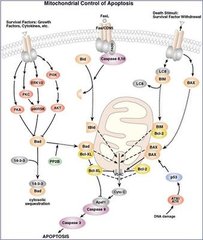JNCI:FLCN能调控线粒体氧化代谢
Birt-Hogg-Dubé (BHD)综合征是一种遗传性错构瘤综合征,使得患者容易罹患毛囊肿瘤、肺囊肿和肾癌。针对BHD患者的遗传性研究揭示了责任基因——FLCN——但是对它的功能理解还不甚其详。Hisashi Hasumi等进行的相关研究发表在JNCI 12月最新的在线期刊上。
FLCN和/或过氧化物酶体增殖物激活受体γ辅助激活子1α (PPARGC1A)遗传状态小鼠与肌酸激酶(CKM)-Cre或Myogenin(MYOG)-Cre小鼠杂交,以敲除肌肉中的FLCN和/或PPARGC1A,或与Cadherin16(CDH16)小鼠杂交以敲除肾脏中的FLCN和/或PPARGC1A,PPARGC1A是一种调控线粒体生物合成的转录辅因子。采用实时聚合酶链反、免疫印迹法、电子显微术和代谢谱分析法评估线粒体生物合成和肌肉功能。应用免疫印迹法、电子显微术和组织学分析调查在FLCN缺陷的肾脏内PPARGC1A的表达情况和病理作用。在无FLCN肾癌细胞中进行实时聚合酶链反应、耗氧量评个和流式细胞仪分析。所有统计分析皆为双侧分析。
剔除了肌肉FLCN基因小鼠会出现显着的向氧化磷酸化代谢转变,包括线粒体生物活性增强,所观察到线粒体生物活性增加与PPARGC1A相关。将无FLCN肾癌细胞和野生型FLCN结合能抑制线粒体代谢和PPARGC1A表达。肾脏PPARGC1A失活可部分改善增大的肾脏表型以及减少在FLCN功能不全肾脏中细胞增生。
FLCN缺陷和PPARGC1A表达增加会导致线粒体功能增加以及氧化代谢增加导致细胞能量增加,这有利于FLCN缺失肾细胞生长,以及促进增生性转化。
doi: 10.1093/jnci/djs418
PMC:
PMID:
Regulation of Mitochondrial Oxidative Metabolism by TumorSuppressor FLCN
Hisashi Hasumi, Masaya Baba, Yukiko Hasumi,Ying Huang, Hyoungbin Oh,Robert M. Hughes, Mara E. Klein, Shoichi Takikita,Kunio Nagashima,Laura S. Schmidt and W. Marston Linehan
Background Birt-Hogg-Dubé (BHD) syndrome is ahereditary hamartoma syndrome that predisposes patients to develop hairfollicle tumors, lung cysts, and kidney cancer. Genetic studies of BHD patientshave uncovered the causative gene, FLCN, but its function is incompletelyunderstood.Methods Mice with conditional alleles of FLCN and/or peroxisomeproliferator-activated receptor gamma coactivator 1-alpha (PPARGC1A), a transcriptional coactivator thatregulates mitochondrial biogenesis, were crossbred with mice harboring eithermuscle creatine kinase (CKM) –Creor myogenin (MYOG) –Cre transgenes to knockout FLCN and/orPPARGC1Ainmuscle, or cadherin 16 (CDH16)– Cre transgenes to knock out FLCN and/or PPARGC1Ain kidney. Real-time polymerase chainreaction, immunoblotting, electron microscopy, and metabolic profiling assaywere performed to evaluate mitochondrial biogenesis and function in muscle.Immunoblotting, electron microscopy, and histological analysis were used toinvestigate expression and the pathological role of PPARGC1Ain FLCN-deficient kidney. Real-time polymerasechain reaction, oxygen consumption measurement, and flow cytometry were carriedout using a FLCN-null kidney cancer cell line. All statistical analyses weretwo-sided.Results Muscle-targeted FLCN knockout mice underwent a pronouncedmetabolic shift toward oxidative phosphorylation, including increasedmitochondrial biogenesis (FLCN f/f vs FLCN f/f /CKM–Cre: % mitochondrial areamean = 7.8% vs 17.8%; difference = 10.0%; 95% confidence interval = 5.7% to14.3%; P < .001), and the observed increase in mitochondrial biogenesis wasPPARGC1Adependent.Reconstitution of FLCN-null kidney cancer cells with wild-type FLCN suppressedmitochondrial metabolism and PPARGC1Aexpression. Kidney-targeted PPARGC1Ainactivation partially rescued the enlarged kidney phenotype and abrogated thehyperplastic cells observed in the FLCN-deficient kidney.Conclusion FLCNdeficiency and subsequent increased PPARGC1Aexpression result in increased mitochondrial function and oxidative metabolismas the source of cellular energy, which may give FLCN-null kidney cells agrowth advantage and drive hyperplastic transformation.
 此主题相关图片如下:1.jpg
此主题相关图片如下:1.jpg